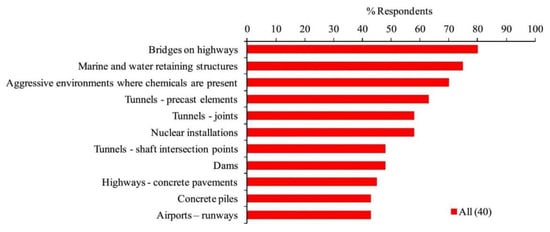Cracking is one of the main ways that concrete ages, allowing pollutants to seep within and potentially lowering the physical and mechanical strength and endurance of concrete structures. One of the healing procedures that merits research is the use of bacterially generated calcium carbonate precipitation in concrete mixtures to mend concrete cracks.
- MICP
- self-healing concrete
- bacterial concrete
- cracking
- Sealingability
1. Introduction
2. Factor Affecting the MICP
2.1. Nucleation Site
2.2. Bacterial Type
2.3. Bacterial Concentrations and Ureolytic Activity
2.4. PH
2.5. Nutrients
2.6. Temperature
3. Tests for Assessing the Bio-Mineralized Calcium Carbonate Based SELF-Healing Concrete
Several methods for evaluating the crack self-healing effect were put forth in order to evaluate the potential of microbial self-healing concrete (MSHC) to close cracks. For instance, X-ray diffraction, scanning electron microscopy, and energy dispersive spectroscopy (XRD) [137,138] were employed to examine the shape of crystals that precipitated at the break. The ability of the bio-mineralized self-healing precipitate was further evaluated using water permeability, porosity, and chloride ion permeation resistance [139,140] and nondestructive detection methods including ultrasonic and acoustic emission were used to assess the effectiveness of bio-self-healing. concrete [141,142,143,144]. TEM analysis was used to assess the sealing ability or deposition of MICP by [124] on archeological gypsum plasters employed M. xanthus bacteria. However, characterization techniques like SEM, XRD, and water permeability are only suitable for testing in the lab and not real engineering since they cannot concurrently satisfy the demands of operability and nondestructive testing. Acoustic emission and ultrasonic technology are expected to be heavily used in practical engineering due to the advantages of simple detecting equipment, practical operation, and economical detection. The majority of MSHC research is based on previously published experiments.
However, several scientists have chosen to use measurements of the deposited minerals to confirm the encapsulation of bacteria in self-healing concrete [91,145,146,147,148]. In the realm of encapsulating materials in self-healing concrete, techniques of testing based on the restoration of mechanical characteristics by the transmission of ultrasonic waves are still unexamined. Quantification of precipitated crystals in cementitious and biochar materials has been investigated using TGA for concrete or mortar samples.
Microstructure tests are carried out using tools including scanning electron microscopes (SEMs), field-emission scanning electron microscopes (FESEMs), and X-ray diffraction to identify and describe embedded materials after self-healing (XRD) [173] used bio-cement with a variable urea-CaCl2 and bacterial cell density concentration. Based on its 40% greater compressive strength than conventional concrete, improved material finish, aesthetic qualities, and environmental effect, the authors came to the conclusion that bio-cement has potential as a sustainable design material.
ATRIR [149,152] revealed the chemical composition of the deposit, which consisted of a calcite and aragonite combination in addition to two CaCO3 polymorphs. For more confirmation of the characterization results, the XRD is frequently employed, along with SEM-EDX by various researchers provided in Table 2. This method was utilized to search for verified healing agents in the precipitates based on macrostructural and SEM inspection. The most prevalent microstructural test used by investigators to trace deposition products in crack specimens was SEM analysis [175]. In addition, for qualitative and quantitative elemental analysis, several researchers have combined EDS with SEM [163,164,176,177]. X-ray tomography, Raman spectroscopy, and Nuclear Magnet Resonance (NMR) can be utilized to monitor and study crack healing qualitatively and quantitatively besides the existing microstructure level research [178,179]. The nanotechnology level study of self-restoration effectiveness by bacteria encased materials has yet to be completed. These tests are performed to ensure that the results of the microstructural testing are as reliable as possible. Nanoscale tests should be performed to determine the bonding strength within the fractures at the interface between the deposited minerals and the cement substrate [180].
4. Sealing Ability and Recovery of Mechanical and Durability Properties
4.1. Recovery of Mechanical Properties
Wang [190] used glass tubes to encapsulate bacteria cells in PU and silica gel. The crack width used to measure mechanical strength recovery was around 0.35 mm. In the case of silica gel, there was more calcium carbonate precipitation, but only around 5% strength recovery. PU-containing specimens recovered between 50 and 80 percent of their potency. Conversely, the bacterial role in regaining mechanical strength was questioned because the strength recovery for live and dead bacteria cells was not significantly different. The precipitate quantity was larger in silica gel than in PU, although PU had a higher strength recovery. It’s reasonable to assume that PU, as an excellent sealing agent, played a major role in the mechanical strength recovery.
4.2. Recovery of Durability Properties
5. Field Application of Bio-Mineralized Self-Healing Concrete

This entry is adapted from the peer-reviewed paper 10.3390/cryst12091222
